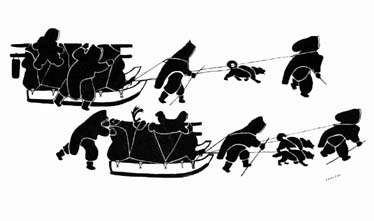Table of Contents
*
We Are Not Alone
*
Research Paper II: Occupational Osteoarthritis
*
Who is an ISDI "Member"
*
Northern Inuits (sic), Again!
*
High Arctic Mushing: Part IV
*
The Inuit Dog: Its Provenance, Environment and History
*
Preserving "Bear" Dogs
*
Janice Howls: Extinction
*
IMHO: Little Minds, Little Worlds
*
Index of The Fan Hitch, Volume IV
Navigating This
Site
Index of articles by subject
Index
of back issues by volume number
Search The
Fan Hitch
Articles
to download and print
Ordering
Ken MacRury's Thesis
Our
comprehensive list of resources
Talk
to The Fan
Hitch
The Fan Hitch
home page
ISDI
home page
Editor: Sue Hamilton
Webmaster: Mark Hamilton
Contents of The Fan Hitch Website and its publications are protected by international copyright laws. No photo, drawing or text may be reproduced in any form without written consent. Webmasters please note: written consent is necessary before linking this site to yours! Please forward requests to Sue Hamilton, 55 Town Line Rd., Harwinton, Connecticut 06791, USA or mail@thefanhitch.org

Illustration by Ekootak, reprinted with
permission from
I,Nuligak, by Nuligak, edited and
translated by Maurice Metayer. Toronto:
Peter Martin
Associates, 1966.
Extinction
by Janice Dougherty
A newspaper column entitled "Snatched From the Jaws of Extinction" (New York Times /June 5, 2002) reviewed a book called The Ghost with Trembling Wings by Scott Weidensaul. I had cut it out for more considered reading, subsequently misplaced it, and then found it again, with certain passages I had already underlined: "the world is witnessing a major wave of extinctions caused by human beings: by changes wrought in the environment by the population explosion, by industrial and agricultural development and by climate change." I further marked: "the handful of organisms once thought to be extinct, that have been rediscovered, lurking in isolated habitats or hiding from the human eye, sometimes hanging on by the thinnest of threads." Again, mention is made of "the wishful thinking that leads people to look for monsters in Loch Ness and black panthers in the bucolic wilds of England". The piece ends with the following: "Indeed, the rediscovery of certain lost species, not to mention talk about the theoretical possibility of cloning extinct animals, à la "Jurassic Park", may give people false hope that extinction can easily be reversed. How joyful, really, is the resurrection of a species, if the modern world cannot find a single safe haven for it… and if it seems doomed to slip into limbo once more anyway?"
Some weeks later, I read a piece by Mark Derr entitled "Crossbreeding to Save Species and Create New Ones", primarily dealing with the Florida Panther and the Red Wolf. Today's mail brought a flier from the American Livestock Breeds Conservancy regarding a conference in September entitled: "Green Genes: Choosing Genetics for Sustainable Livestock Production", with segments on sustaining conservation to make rare breeds secure for the long term, selecting genetics for good health, fertility, etc. Meanwhile, the actor Harrison Ford, who is usually quite reticent in public, is campaigning for an organization called Conservation International while chatting in television interviews about his latest blockbuster movie. Last evening I hid from the heat wave with Jean Auel's Shelters of Stone, and while reading the acknowledgments, she writes a special thanks to Lenette Stroebel of Prineville, Oregon, who has been breeding back from wild horses to the original Tarpan, and turning up some interesting characteristics. For example, they have hooves so hard they don't need horseshoes even on rocky ground, they have a stand up mane, and they have markings similar to the horses painted on some cave walls…
Of course, you know all this makes me think about the Inuit Sled Dog, and how this relates back to the situation we have now, so clearly defined in the previous edition of The Fan Hitch by both Mark Hamilton and Geneviève Montcombroux. We have a breed of dog that is more than deserving of preservation, for which tremendous efforts have already been made, but which has a very limited market appeal if we are to be honest in their conservation. We are pretty much on our own in maintaining a viable gene pool. The cavalry is not on its way to our rescue. Other not-so-easy-to-place dog breeds have made various compromises in their public image in order to establish a protected place for themselves in the mind of the public. And as Mark has pointed out, the livestock people can (literally) eat their mistakes. In mid-September, Sue Hamilton and I will go to the Tufts University Expo with an eye toward attending presentations on the tricky behavioral/legal issues that are as much a part of the threat to the working ISD as anything else. There is the ever present problem of other groups appropriating parts of the Inuit Sled Dog breed name and heritage to pawn off lupus cross and malamute cross canines as pets, sullying the name and reputation of the ISD, and creating legal headaches for all of us.
I recall the interview with Bill Carpenter (NY Times, 01/31/01) where he remarked that if the Inuit Dogs were some wild species, people would be falling all over themselves to send money trying to save them from extinction. Well, it is up to us now, and we've come to a turning point where some hard decisions must be made. Do we put our money, time, and brains where our mouth is, or do we let the ISD be snatched by the jaws of extinction?